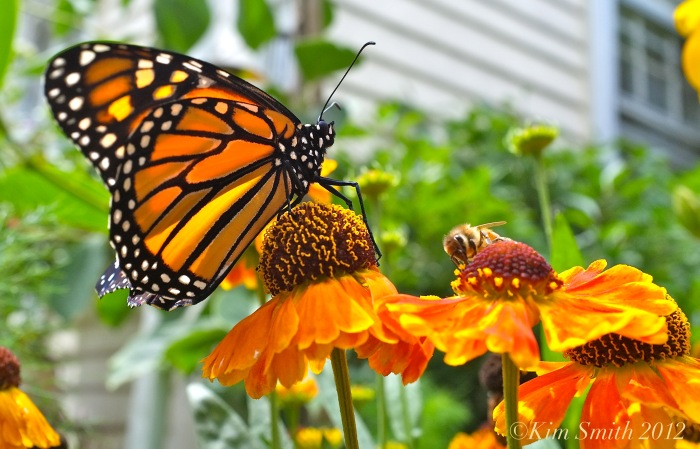Bees, butterflies, and songbirds bring a garden to life, with their grace in movement and ephemeral beauty.  Many of the plants that are the most highly attractive to butterflies are also the most appealing to bees, too!
Many of the plants that are the most highly attractive to butterflies are also the most appealing to bees, too!
Bees are also a “keystone organism,” which means they are critical to maintaining the sustainability and productivity of many types of ecosystems. Without bees, most flowering plants would become extinct, and fruit and seed eating birds and mammals (such as ourselves) would have a much less healthy and varied diet.
Native bees come in an array of beautiful colors, size, and shapes. Some are as small as one eighth of an inch and others as large as one inch. They may wear striped suits of orange, red, yellow, or white, or shimmer in coats of metallic iridescene. Their names often reflect the way in which they build their nests, for example, carpenter bees, leafcutter bees, mason bees, plasterer bees, digger bees, and wool carder bees.
Approximately 4,000 species of native bees have been identified north of Mexico. They are extremely efficient pollinators of tomatoes, apples, berries, pumpkins, watermelons, and many other crops.
 Native Carpenter Bee and Apricot Tree
Native Carpenter Bee and Apricot Tree
Listed below are what I have found to be the most successful tips for supporting and attracting native bees to your garden.
1). Choose plants native to North America. Over millennia, native bees have adapted to native plants. If planting a non-native plant, do not plant invasive aliens, only well-behaved ornamentals.
2). Choose non-chemical solutions to insect problems, in other words, do not use herbicides or pesticides.
3). Choose plants that have a variety of different flowers shapes to attract a variety of bees, both long-tongued and short-tongued bees.
4). Avoid “fancy” plants, the hybrids that have been deveolped with multiple double frilly layers. This only confuses bees when they are looking for nectar and gathering pollen.
5). Provide a succession of nectar-rich and pollen bearing blooms throughout the growing season. Select plants that flower during the earliest spring, during the summer months, and until the first hard frost.
6.) Plant a clover lawn, or throw some clover seed onto your existing grass lawn to create a mixed effect.
7.) Bee Friendly–bees only sting when provoked. When encountering an angry bee, stay calm and walk away slowly.
8.) Plant lots of blue, purple, and yellow flowers, a bees favorite colors.
9). Provide a source of pesticide-free water and mud in your bee paradise.
The first nine tips are for any garden, large or small. The last is for people with larger land areas.
10). Establish hedgerows, or clumps of native woody shrubs and trees, and wildflower fields. Contact the USDA NRCS (Natural Resources Conservation Services) for available funding opportunities.
Tomorrow I’ll post our top ten native plants for attracting and supporting native bees.
 One of the most elegant of all native trees is the not-widely planted Cornus alternifolia, or Pagoda Dogwood. Where ever I plant this tree of uncommon grace and beauty it becomes a magnet for all manner of bees and butterflies.
One of the most elegant of all native trees is the not-widely planted Cornus alternifolia, or Pagoda Dogwood. Where ever I plant this tree of uncommon grace and beauty it becomes a magnet for all manner of bees and butterflies.

Wonderful, Kim! You do a fabulous job!
LikeLike
Thank you Nat, very much appreciated!
LikeLike
This is great. And necessary. Thank you, Kim!
LikeLike
Thanks Chris. More about specific plant groups tomorrow–too much to do today to finish the list
LikeLike
As usual, your photos are stunning. I’ll have to share them with little Adriana (3 yrs.) as she’s at that “Age of Wonder.”
And thanks for the bee tips. I think I have the only yard in my community which doesn’t have chemicals on it. (All right, so it will never look like Martha Stewart’s.) I even get a humming bee from time to time.
LikeLike
Thank you Leslie for your always kind and supportive comments!
Wow, that is discouraging in this day and age re your community–time for you to put on your educator hat maybe?
LikeLike
I meant “humming bird,” lol.
Don’t need my Educator Hat. My neighbor across the street is a college grad. Years ago, I mentioned to her that the run off (we’re on an incline) feeds right into the nearby river when it rains. She gave me the “deer caught in a flashlight, stare.” When I see the Chem-lab truck come, I cringe.
LikeLike
I thought you meant humming bird clearwing moth, which is sometimes mistaken for a bee.
I am so sorry about your neighbors Leslie. I have read that that the chemicals from chemical lawn care products is the heaviest polluter of our streams, waterways, and shellfish beds, far more so even than agricultural run-off from large-scale farms.
Years ago I threw some clover seed onto our little postage stamp lawn. It comes back beautifully each year and, I think because of the nutrients added to the soil by the perennial clover, we never have to water or feed our lawn.
LikeLike
I have some clover in my lawn. My good friend and fellow tennis player, tipped me off years ago, about how it nurtures the grass. She’s a farm lady who raises llamas and goats, ducks, and is a bee keeper. She has a Masters in bio chemistry from UNH, so I don’t discount her info!
I have a picture of what I thought was a hummingbird at my flower, but on closer inspection was not. Reminded me of a giant bug, but not, lol. If I can find it, I’m going to send it to you for identification!
LikeLike
Okay great, would Love to see it!
LikeLike